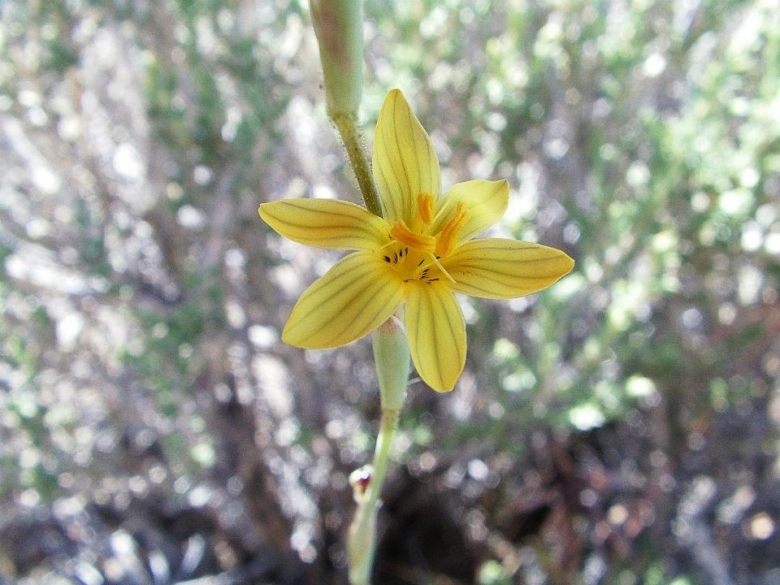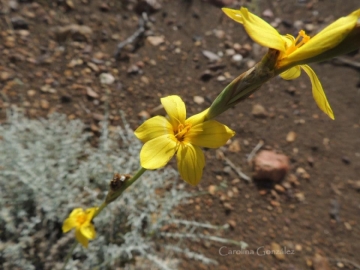
Sisyrinchium arenarium Photo by: Carolina González
Origin and Habitat: Sisyrinchium arenariumSN|30830]]SN|30830]] is patchily distributed in Southern Chile and Argentinian Patagonia.
Altitude range: 700-1900 m; down to sea level in the extreme south.
Habitat and ecology: This species is found throughout the subandean scrub zone, growing fully exposed to the sun or in partial shade between the dominant shrubs, usually in somewhat dry sites where the drought may last 3 - 5 months. Precipitations of 400 - 800 mm are concentrated in winter. It also spreads in more humid areas, with almost constant rainfall.
Synonyms:
See all synonyms of Sisyrinchium arenarium
Common Names include:
ENGLISH: Yellow Eyed Grass
SPANISH (Español): Ñuño, Huilmo amarillo
Description: Sisyrinchium arenarium is a delicate herbaceous perennial herb, 20 to 50 cm tall, with grass-like leaves. The gold-yellow star-shaped flowers have very fine brownish veins and bloom during spring and early summer. This species is often confused with and like Sisyrinchium striatum, but having fleshy roots and flowering stems only slightly flattened.
Flowers: Diurnal, small (2-3 cm) sometimes in terminal clusters only. Perianth lobes (tepals) six and equal, creamy light yellow to golden yellow with grey-brown veins.
Leaves: Linear, grassy green.
Fruits (capsules): Three celled containing 20 to 30 black, spherical seeds, 2 to 3
mm in diameter.
Subspecies, varieties, forms and cultivars of plants belonging to the Sisyrinchium arenarium group
Bibliography: Major references and further lectures
1) Institute of Arctic and Alpine Research “Arctic, Antarctic, and Alpine Research”, Volume 34 , University of Colorado-Boulder, 2002
2) Alejandro A. Muñoz; Mary T. K. Arroyo “Postdispersal Seed Predation on Sisyrinchium arenarium (Iridaceae) at Two Elevations in the Central Chilean Andes” Arctic, Antarctic, and Alpine Research, Vol. 34, No. 2. (May, 2002), pp. 178-184.
3) Govaerts, R.H.A. “World checklist of selected plant families published update. Facilitated by the Trustees of the Royal Botanic Gardens, Kew.” 2011
4) Múlgura, M.E. “Catálogo de las Plantas Vasculares de la República Argentina” 1: 205-217. Missouri Botanical Garden, St. Louis. 1996
5) Rodriguez Rios, R. “Die Chilenischen Arten der Gattung Sisyrinchium L. (Iridaceae).” Mitteilungen der Botanischen Staatssammlung München. München 22: 97-201. 1986
6) The Alpine Garden Society “Sisyrinchium arenarium” <http://encyclopaedia.alpinegardensociety.net> Web. 19 Mar. 2015.
 Sisyrinchium arenarium Photo by: Carolina González
Sisyrinchium arenarium Photo by: Carolina GonzálezSend a photo of this plant.The gallery now contains thousands of pictures, however it is possible to do even more. We are, of course, seeking photos of species not yet shown in the gallery but not only that, we are also looking for better pictures than those already present.
Read More... Cultivation and Propagation: Sisyrinchium arenariumSN|30830]]SN|30830]] is an Alpine specie recommended for borders, to naturalize on a meadow, in flowerbeds, pots, containers, etc. Can be used as cut flower. It is certainly a beautifully delicate plant that merits cultivation. Lots of light and good drainage are a must.
Soil: It should be potted in a mixture of peat sand and loam and protected in a cold frame.
Water: Do not over water.
Hardiness: The plant tolerates low temperatures (-8° C or less), can tolerate occasional snow cover for up to a couple of weeks per year. USDA Hardiness Zone 8.
Maintenance: Deadhead the flowers and only keep the seed pods you will require for further propagation of your sisyrinchiums. This will prevent the rhizome to age too soon.
Use: They make superb rock garden plants, as well as adequate for the front of a border as well as being perfect for pots and containers, where they will be more reliably perennial, multiplying up yearly.
Propagation: It may be propagated by offsets and probably by seeds. Sow them during autumn, in a mix of equal parts of compost, regular garden soil and sharp river sand. Cover this mix with a layer of sand, distribute the seeds and spread some more sand over them to barely cover the seeds. Place your sowing pan in a cold frame or cold greenhouse if you have heavy rain in your area. If you have snow, place the sowing pan outdoors and let nature do its work. The seedlings can be transplanted once they are 5cm tall. These pretty plants can bloom the first year grown from seeds, but will display their best from the second year on.










